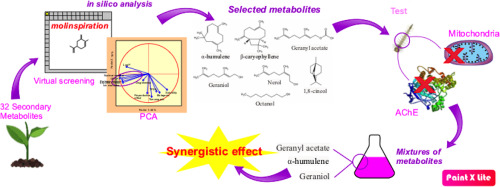当前位置:
X-MOL 学术
›
Comp. Biochem. Physiol. C Toxicol. Pharmacol.
›
论文详情
Our official English website, www.x-mol.net, welcomes your feedback! (Note: you will need to create a separate account there.)
Model to design insecticides against Aedes aegypti using in silico and in vivo analysis of different pharmacological targets.
Comparative Biochemistry and Physiology C: Toxicology & Pharmacology ( IF 3.9 ) Pub Date : 2019-11-07 , DOI: 10.1016/j.cbpc.2019.108664 Mayra A Borrero-Landazabal 1 , Jonny E Duque 2 , Stelia C Mendez-Sanchez 3
Comparative Biochemistry and Physiology C: Toxicology & Pharmacology ( IF 3.9 ) Pub Date : 2019-11-07 , DOI: 10.1016/j.cbpc.2019.108664 Mayra A Borrero-Landazabal 1 , Jonny E Duque 2 , Stelia C Mendez-Sanchez 3
Affiliation

|
Compounds having insecticidal activity can be used to control Aedes aegypti mosquitoes, a major worldwide vector, and several plants have a source of such molecules. A principal component analysis (PCA) was carried out to determine the criterion to select larvicidal metabolites. The insecticidal activity of seven selected metabolites by PCA was validated by determining its lethal concentrations 50 (LC50) by probit analysis. Six of the seven evaluated molecules presented LC50 values <100 ppm. The effects of these six molecules on acetylcholinesterase and the respiratory chain complexes of the mitochondria of Ae. aegypti were evaluated. Four metabolites presenting the highest inhibition effects on these targets were mixed in 11 different combinations, and the percentage of mortality of each mixture on Ae. aegypti larvae were determined. Secondary metabolites such as geranyl acetate, α-humulene, β-caryophyllene, geraniol, nerol, and n-octanol presented LC50 values under 100 ppm (44, 41, 48, 84, 87, and 98 ppm, respectively), whereas 1,8-cineole presented a LC50 value of 183 ppm. We found that, geranyl acetate, α-humulene, β-caryophyllene, nerol, n-octanol, and geraniol inhibited at least one of the six targets with an efficiency between 25 and 41%. Overall, the evaluation of the different mixtures revealed a synergistic effect between geranyl acetate and geraniol, and an antagonistic effect between α-humulene and β-caryophyllene compounds.
中文翻译:

使用计算机模拟和对不同药理目标进行体内分析,设计针对埃及伊蚊的杀虫剂。
具有杀虫活性的化合物可用于控制埃及伊蚊,这是世界范围内的主要媒介,几种植物都有这种分子的来源。进行了主成分分析(PCA),以确定选择幼虫代谢物的标准。通过概率分析确定其致死浓度50(LC50),验证了PCA对7种选定代谢物的杀虫活性。七个评估分子中的六个呈现的LC50值<100 ppm。这六个分子对乙酰胆碱酯酶和Ae线粒体呼吸链复合物的影响。对埃及埃及进行了评估。将对这些靶标表现出最高抑制作用的四种代谢物混合成11种不同的组合,每种混合物对Ae的死亡率百分比。确定埃及伊蚊幼虫。次生代谢产物,例如乙酸香叶酯,α-腐草烯,β-叶绿素烯,香叶醇,神经醇和正辛醇的LC50值分别低于100 ppm(分别为44、41、48、84、87和98 ppm),而1, 8-桉树脑的LC50值为183 ppm。我们发现,乙酸香叶酯,α-腐植烯,β-叶绿素烯,神经醇,正辛醇和香叶醇可抑制六个目标中的至少一个,效率在25%至41%之间。总的来说,对不同混合物的评价显示乙酸香叶酯和香叶醇之间的协同作用,以及α-腐草烯和β-石竹烯化合物之间的拮抗作用。我们发现,乙酸香叶酯,α-腐植烯,β-叶绿素烯,神经醇,正辛醇和香叶醇可抑制六个目标中的至少一个,效率在25%至41%之间。总的来说,对不同混合物的评价显示出乙酸香叶酯和香叶醇之间的协同作用,以及α-hu草烯和β-石竹烯化合物之间的拮抗作用。我们发现,乙酸香叶酯,α-腐殖烯,β-叶绿素烯,神经醇,正辛醇和香叶醇可抑制六个目标中的至少一个,效率在25%至41%之间。总的来说,对不同混合物的评价显示出乙酸香叶酯和香叶醇之间的协同作用,以及α-hu草烯和β-石竹烯化合物之间的拮抗作用。
更新日期:2019-11-07
中文翻译:

使用计算机模拟和对不同药理目标进行体内分析,设计针对埃及伊蚊的杀虫剂。
具有杀虫活性的化合物可用于控制埃及伊蚊,这是世界范围内的主要媒介,几种植物都有这种分子的来源。进行了主成分分析(PCA),以确定选择幼虫代谢物的标准。通过概率分析确定其致死浓度50(LC50),验证了PCA对7种选定代谢物的杀虫活性。七个评估分子中的六个呈现的LC50值<100 ppm。这六个分子对乙酰胆碱酯酶和Ae线粒体呼吸链复合物的影响。对埃及埃及进行了评估。将对这些靶标表现出最高抑制作用的四种代谢物混合成11种不同的组合,每种混合物对Ae的死亡率百分比。确定埃及伊蚊幼虫。次生代谢产物,例如乙酸香叶酯,α-腐草烯,β-叶绿素烯,香叶醇,神经醇和正辛醇的LC50值分别低于100 ppm(分别为44、41、48、84、87和98 ppm),而1, 8-桉树脑的LC50值为183 ppm。我们发现,乙酸香叶酯,α-腐植烯,β-叶绿素烯,神经醇,正辛醇和香叶醇可抑制六个目标中的至少一个,效率在25%至41%之间。总的来说,对不同混合物的评价显示乙酸香叶酯和香叶醇之间的协同作用,以及α-腐草烯和β-石竹烯化合物之间的拮抗作用。我们发现,乙酸香叶酯,α-腐植烯,β-叶绿素烯,神经醇,正辛醇和香叶醇可抑制六个目标中的至少一个,效率在25%至41%之间。总的来说,对不同混合物的评价显示出乙酸香叶酯和香叶醇之间的协同作用,以及α-hu草烯和β-石竹烯化合物之间的拮抗作用。我们发现,乙酸香叶酯,α-腐殖烯,β-叶绿素烯,神经醇,正辛醇和香叶醇可抑制六个目标中的至少一个,效率在25%至41%之间。总的来说,对不同混合物的评价显示出乙酸香叶酯和香叶醇之间的协同作用,以及α-hu草烯和β-石竹烯化合物之间的拮抗作用。


























 京公网安备 11010802027423号
京公网安备 11010802027423号